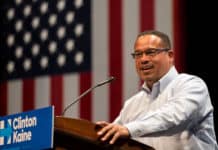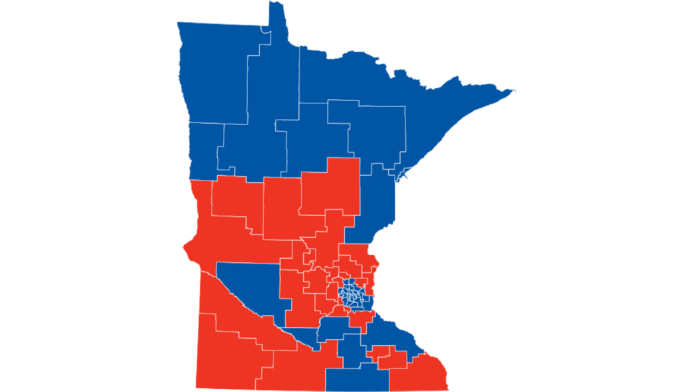The entirety of the Minnesota State Senate and House of Representatives is up for election on November 8. With 201 total legislative seats in play, Republicans only need to pick up six more Senate seats to gain control in that chamber, while the DFL only needs seven pick ups to take control of the House. With that in mind, here are 14 Senate races to watch going into Tuesday.
Senate District 1 – Kip Fontaine (DFL) vs. Mark Johnson (R)
Long time incumbent DFL Sen. Leroy Stumpf is retiring this year after 34 years in the Senate. While he won reelection with over 60 percent of the vote in 2012, the district leans Republican in most other cases. The two house seats in this district were won 67-33 and 56-44 by Republicans in 2014, and the district went 53-44 in favor of Mitt Romney in 2012. Money spent to help Republicans is also nearly eight times that for the DFL here. The district is likely a Republican gain.
Senate District 2 – Sen. Rod Skoe (DFL) vs. Paul Utke (R)
This is another district which leans more conservative but has a DFL Senator. Unlike in SD1 though, the incumbent is not retiring. Skoe has held on to the seat for three terms now, winning 55-45 most recently in 2012. Both of the House seats here are held by Republicans however, with 2014 margins going 52-48 and 57-43. Romney also won here in 2012, by a similar margin as SD1. This is a toss-up, but the popularity of incumbent Sen. Skoe and pro-DFL spending eclipsing GOP levels by over $120,000 may give Skoe the edge he needs to hang on.
Senate District 4 – Sen. Kent Eken (DFL) vs. James Leiman (R)
This district leans heavily Democrat in the House races, with 58-42 and 66-34 margins in 2014. That is less true in election years for the State Senate race. Eken won his first term in 2012 with 52 percent of the vote, and while President Obama won the district in 2012, it was with slightly less than 51 percent. Spending in favor of Republicans is also nearly $90,000 greater than that for the DFL, putting this district more in play then it typically is.
Senate District 14 – Dan Wolgamott (DFL) vs. Jerry Relph (R)
This is a true toss-up district, with perhaps just the slightest of conservative leanings. Incumbent Sen. John Pederson is retiring after two terms, having won re-election in 2012 with a 52-47 margin. Both house seats are also held by Republicans here, but the margins are much closer. Rep. Tama Theis won 55-45, and Rep. Jim Knoblauch won with 50.15 percent of the vote compared to 49.54 for his DFL opponent, and both of those races are also likely to be close. In SD14 Democrats hold a nearly $190,000 spending advantage for Wolgamott. The GOP is somewhat fractured here due to the CD6 rift between the Tom Emmer and AJ Kern camps, but a recent ISIS inspired stabbing in St. Cloud may encourage voters to think strong national security, and Republicans further down ticket would likely benefit from such a mentality as well.
Senate District 17 – Sen. Lyle Koenen (DFL) vs. Andrew Lang (R)
Koenen has a very conservative voting record for the DFL, as his district also tends to lean more conservative. Republicans hold both house seats, with 2014 results being very similar to those of SD14’s house seats. Romney took the district 51-47 in 2012. Koenen won his first term in the Senate after 10 years in the House with a 55-45 margin. DFL spending is around $330,000 in this race, while the GOP has mustered $270,000. Lang is a Minnesota National Guard officer and pilot.
Senate District 20 – Sen. Kevin Dahle (DFL) vs. Rich Draheim (R)
This is the truest example of a swing district in Minnesota. Dahle won reelection in 2012 by just 82 votes total. HD20A leans heavily Republican, with Rep. Bob Vogel winning 64-36 in 2014. HD20B leans heavily towards the DFL however, with Rep. David Bly winning 58-42. Romney took SD20 50-47 in 2012. Democrats have been targeting this race much more heavily though, as they hold a nearly 3-1 advantage and a total of $250,000 spending lead. With small colleges such as St. Olaf and Carleton present, student involvement and turnout may play a crucial role in this election.
Senate District 21 – Sen. Matt Schmit (DFL) vs. Mike Goggin (R)
Yet another case where both House seats are held by Republicans, and by large margins here. 62-38 and 63-37 respectively. Schmit won his first term in 2012 with 52 percent of the vote, while Romney won the district with just over 50. Goggin is a well known name in the area as his father used to run the Red Wing Shoe Company. The DFL holds a $370,000 to $290,000 spending advantage thus far.
Senate District 24 – Sen. Vicki Jensen (DFL) vs. John Jasinski (R)
Again, both House seats are held by Republicans and the district went for Romney in 2012. Jensen is a more moderate member of the Senate however, and the Minnesota Chamber of Commerce is actually backing her over her Republican challenger. Jasinski is a two-term Mayor of Faribault however, and a city council member before then, so he is not lacking in name recognition. The spending advantage for the DFL here is more than $250,000 though, and a significant Somali population is also likely to vote overwhelmingly Democratic, especially in the year of Trump.
Senate District 44 – Paul Anderson (R) vs. Deb Calvert (DFL)
Incumbent Sen. Terri Bonoff is making a run against Erik Paulsen in CD3, leaving her current seat open. Bonoff had held onto the seat while pitching a more moderate, business friendly tone. HD44A was won by Rep. Sarah Anderson (R) 56-44 in 2014, while Rep. John Applebaum (DFL) won 44B by a margin of 51-49. Both the candidates for Bonoff’s seats are longtime staffers for their respective parties. Calvert worked for Sen. Amy Klobuchar, while Anderson served as deputy chief of staff for former Governor Tim Pawlenty. This is the most expensive race thus far, with the DFL leading spending $460,000 to to $380,000.
Senate District 48 – Sen. David Hann (R) vs. Steve Cwodzinski
The Senate Minority Leader is again under threat in a district he won 51-49 in 2012. Spending is even in this district with each party totalling around $360,000. HD48A is held by the DFL, as Rep. Yvonne Selcer won with 50.04 percent of the vote in 2012, but Rep. Jennifer Loon won 48B for the Republicans with 64 percent. Cwodzinski is a well liked teacher, but only just recently moved into the district.
Senate District 51 – Sen. Jim Carlson (DFL) vs. Victor Lake (R)
This district leans slightly Democrat across the board with close elections. Carlson won reelection in 2012 with a 53-47 margin. Both House seats are controlled by the DFL, with both races seeing margins of 51-49 in 2014. Republicans have a slight spending advantage at $79,000 to $72,000. The Chamber of Commerce is remaining neutral in this race, and the Senate DFL campaign has not poured much in the way of resources for Carlson.
Senate District 53 – Sen. Susan Kent (DFL) vs. Sharna Wahlgren (R)
The district leans Democratic. Kent was reelected 52-48, and the two house districts are under split control with 58-41 and 57-43 margins of victory. Obama won the district 51-47 in 2012. In spite of this control, Wahlgren is not a typical conservative and may do well here. While she has a strong pro-business conduct, her socially moderate views and the strong backing of the Chamber of Commerce may pull her through.
Senate District 57 – Sen. Greg Clausen (DFL) vs. Cory Campbell (R)
Clausen washed into the Senate with the rest of the 2012 DFL wave with a 54-46 margin of victory. Both House seats are held by Republicans who won 58-42 in 2014, while Obama won 50-48 in 2012. The DFL has a huge spending advantage here, $305,000 to $85,000. The Chamber of Commerce has remained neutral in this race as well.
Senate District 58 – Tim Pitcher (R) vs. Matt Little (DFL)
This district typically leans heavily Republican, but Pitcher’s performance has been woefully under expectations thus far. Spending on the part of the DFL has put this district further into play. Little holds a spending advantage of $82,000 to $36,000.
Editor’s note: SD58 race incorrectly referred to Matt Little as the Republican underperforming. This has been corrected to reference Tim Pitcher. Also a House race was listed on this article. That has been moved to a separate article regarding House races to watch.


















